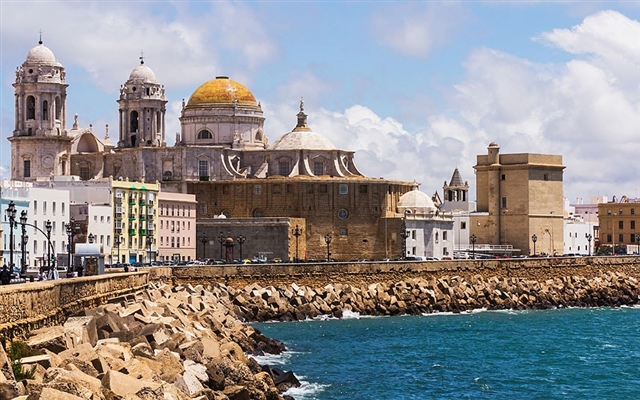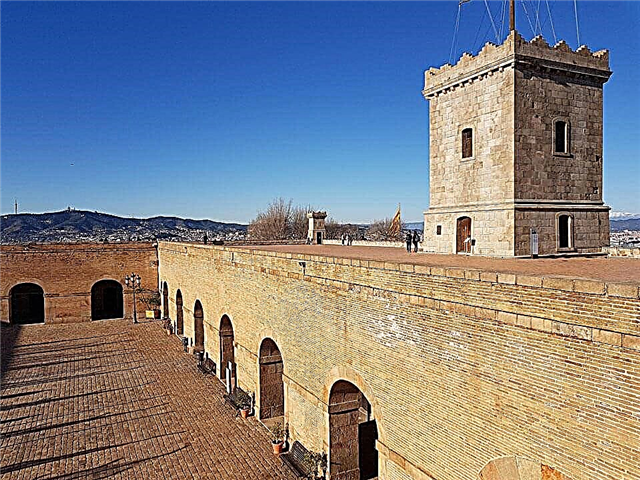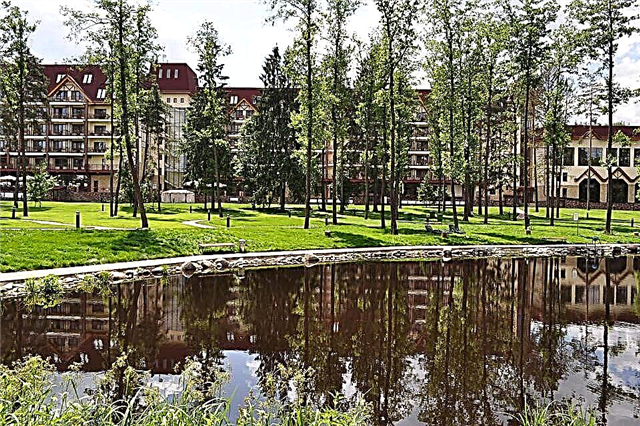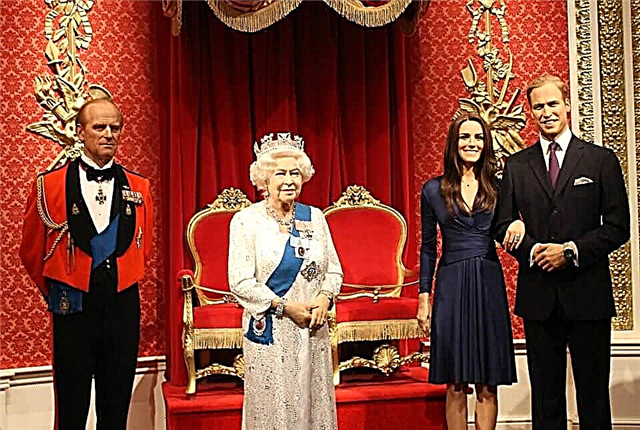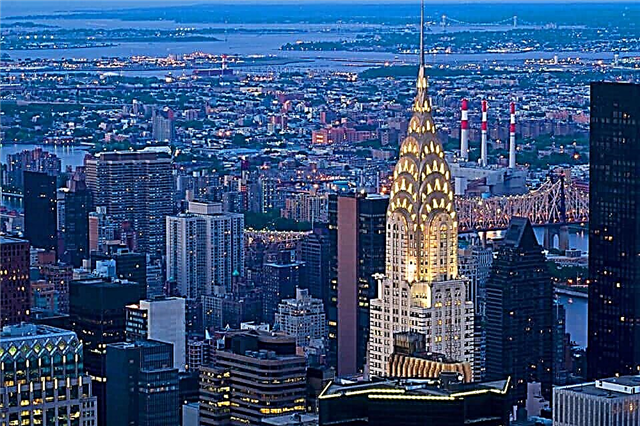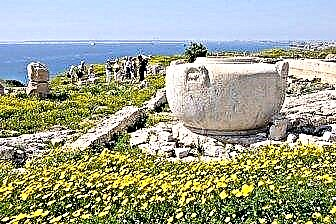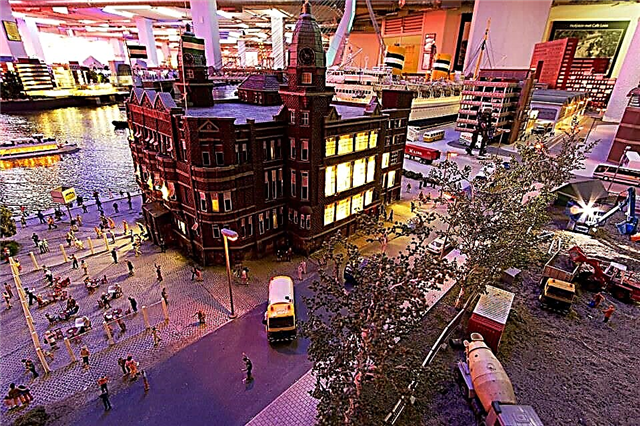There are not many places in Europe that could be called an experimental laboratory of architecture. The sights of Rotterdam are based precisely on this principle - to surprise tourists with unusual buildings in different styles. Nevertheless, the port city is perceived as very organic and inimitable, and the noticeable eclecticism does not bother anyone. One cannot but admire the scope of creative thought when you see all these cubic houses and museums, churches and mosques, the White House and the World Museum. Another "trick" is environmental friendliness, it seems cleanliness and a green area here, even in the port and industrial areas. Everything looks very natural, very clean and well-groomed, but this level is not so easy to achieve. This progress is one of the achievements of the Dutch. Rotterdam city management is making every effort to modernize this part of the land as much as possible, it was clean and comfortable. The city's motto is "Light, air and water!"
Erasmus bridge

Named after Erasmus of Rotterdam, it is considered one of the most beautiful. He connected the city center with the developing area. The longest drawbridge, reaching 802 m, cost 163 million euros. The high cost is due to the complexity of the design, which combines the drawbridge and the suspension bridge.
The asymmetrical creation of the young architect van Berkel - Swan, as the locals call it for its graceful design and the 139-meter curved pylon that rises upwards, took more than 6 years to build. During its construction, the latest techniques and materials were used, which made it possible to build a bridge, the thickness of which does not exceed several meters. Opened in 2006 by Queen Beatrice, it has been further refined for immobility.
Town hall

At the beginning of the XX century. to replace the old Town Hall, which was not as spacious as required, the architect Evers built a new one. Queen Wilhelmina laid the first stone in the foundation, while the shell itself was raised in five years. During the Second World War, the town hall was damaged due to the bombing of the city, but survived. Subsequent restoration gave the pretentious building a new carillon with 48 bells.
The facade of the neo-Renaissance building is decorated with sculptures that convey national characteristics: caution, reliability, perseverance and enterprise, and a statue of the patroness of the city. The building houses the Civic Hall, where official receptions, celebrations and organ music concerts are held. Several years ago, the centuries-old dust was washed off the walls of the City Hall, allowing it to take on its original color.
Euromast

Euromast owes its appearance on the map of the city to the flower festival - Floriade, which is held in Holland every 10 years. In 1960, the honor of hosting the flower extravaganza belonged to Rotterdam, where a competition was announced for the best construction for that date. The winner was the project Hugh Maaskant, who proposed to build a tower in the form of a ship's mast with a bridge at the top. The height of the Euromast was 101 m and ended with a horizontal platform with a glass dome. In 1970, it was decided to complement the structure with an 85-meter space tower, making it the tallest building in the Netherlands.
The tower houses several restaurants (one is distinguished by gourmet cuisine, the other is the usual fast food), a souvenir shop, several suites and 2 observation decks. Visitors can view the cityscape from a height of 100 m - an open observation deck, from where you can go down the rope. The elevator rises and falls along the built-up part, revolving around the axis.
District Delfshaven

Tourists will be able to touch the 300-year history in the area of Rotterdam, which has been preserved even in the bombings of the Second World War, which is located on the right bank of the New Meuse. Once a separate harbor and later a municipality, it is distinguished by its unique architecture. Delfshaven is filled with historic buildings, antique shops, atmospheric pubs and restaurants. The entire area is permeated with a network of canals along which boats scurry.
Attractions in the area include the Church of the Pilgrim Fathers, whose laconic façade is crowned with a bell-shaped superstructure, a restored windmill and the city's only Pilgrim brewery. The replica of the Delft ship, which took part in the battles of the 18th century, is also of constant interest.
Boijmans-van Beuningen Museum

One of the largest museums in the Netherlands will be a real discovery for travelers. The art museum was founded after Frans Jakob Otto Boijmans bequeathed his collection to Rotterdam in 1947. The second significant collection to add to the museum in 1958 was the collection of van Beuningen, which his heirs sold to the museum. The Boijmans-van Beuningen Museum is unusual in everything: from the collection and the exhibition to the building itself. Most of the fund has been donated.
During its existence, thanks to 1.5 thousand private collectors, it was replenished by about 50 thousand objects of art. This is what caused such a variety and selection of authors. The most surprising thing in the museum is the exposition, in which neither the chronology nor the eminence of the creators of the works are observed. Famous names coexist with novice masters, and masterpieces are surrounded by modern installations.
St. Laurentskerk Cathedral

It will no longer be possible to see the original medieval St. Laurentskerk Cathedral - it was badly destroyed. From built in the XVI century. After the bombing of the cathedral, the walls and part of the tower remained, which were restored by 1968. But even from them one could observe the heterogeneity of the structure due to rebuildings and additions, in which the Gothic style of the building was lost.
Among the surviving attractions of the cathedral are the tombs of Admiral Witte de Witt and Franklin Roosevelt's ancestor, Henry Roosevelt, depicting scenes of war and peace with bronze doors and 3 organs. The main organ is the largest in the Netherlands. Organ concerts are often held in the cathedral.
The 65-meter tower serves as an excellent observation deck for a panoramic view. The ascent to it is paid.
Church of St. Lawrence

The Church of St. Lawrence was originally named after the patroness of the poor and hungry St. Elizabeth and was built in two stages. The facade was first built in 1908, which was occupied by the parish church. Later, after World War I, towers were added. The pseudo-Romanesque style that was chosen for the building was reflected in them as well.
During World War II, 2 bombs fell on the church, the integrity of one of which is still disputed. The restored church was made a cathedral in 1956 and the name of the patron saint of Rotterdam, St. Lawrence, was added to the name. Tourists in the cathedral are attracted by the wonderful stained glass windows, sculptures and a mosaic altar.
Museum park

The Museum Park is one of the most unusual places. Its territory is divided into 4 zones: a zone of paths, a zone of romance with a bridge, lawns and flower beds, an urban zone where events are held, and a well-tended garden. The space is decorated with reservoirs, where water flows from the city center during heavy rains. The park got its name because there are many art galleries and museums along its perimeter. This is the famous Boijmans-van Beningen Museum, the Kunsthal Gallery, striking with its unusual architecture, where exhibitions change monthly, the Institute of Architecture, where there are also exhibition halls, the Shabo Museum introducing the art of Rotterdam, the Museum of Natural History and the example of functionalism, the Sonneveld Villa.
Cubic houses

The avant-garde buildings, which the architect called "forest" are difficult to pass by. They represent a cube placed on a hexagonal pylon.It was assumed that a municipal housing district of 55 houses, schools and infrastructure would be erected over the busy highway. The project was carried out by the architect Pete Blom, who built a residential complex of 38 houses. The living space of the house has 3 floors, each of which has a different shape (triangle, polygon and pyramid).
Initially, some of the houses were conceived as residential, while others were intended for offices. But the houses were so much to the taste of tourists, who definitely wanted to look at the arrangement themselves, that one apartment was allocated for a museum. Now everyone can inspect the unusual building and its arrangement.
Botanical Garden "Arboretum Trompenburg"

The Arboretum Trompenberg Botanical Garden is a paradise for true nature lovers. There are no entertainment zones or cafes, the entire territory is divided into zones with a skillfully created microclimate and irrigation system. The garden began with a private collection that dates back to the mid-19th century. to the surname Van Hoi Smith. At that time, the 7-hectare arboretum was located on the outskirts of the city.
Over the years, family members have added to the collection. But the Arboretum turned out to be in the very center of the city and taxes were too heavy for a private person. In 1996, a management fund was created, which owns the botanical garden. Every year more than 50 thousand visitors come to the garden to admire the largest collection of oaks, beeches, rhododendrons, rogers and succulents.
Bladeorp Zoo

Bladeorp, one of the most beautiful zoos in Europe, is a favorite place for residents and visitors alike. The collection of animals gathered here is very rich; many rare specimens. The zoo is divided into thematic zones: Amazonica, Africa, Asia, Riviera, Ice Cave, Oceanium, etc. Some zones are occupied by covered pavilions, as part of the Amazon, where huge and small butterflies were placed, or Oceanium, which is offered to be viewed from a glass tunnel.
Other areas are in open-air enclosures, like Africa with okapis and lowland gorillas, America with vicuñas and bison. In the zoo, tourists can watch the feeding of animals, the schedules of which are specified on the official website, or for 2 € appear as a favorite animal in the picture.
Embankment of sculptures

A free open-air gallery can be called the embankment of the Westersingel canal. It houses 17 art objects: unusual sculptures and provocative installations, which are available at any time of the day. Among them are works by Karl Visser, Umberto Mastroianni, Auguste Rodin, Joel Shapiro and others. Some of them are installed on special pedestals, such as “The Marching Man”, “The Big Musician”, “Farewell” or “Lying Figure”. Others are placed in the middle of the lawn - "Height", representing a tree hovering a meter above the ground, or multicolored logs or caterpillars arranged in a checkerboard pattern.
Shapiro's extraordinary sculpture once caused a storm of indignation among the residents. They found "Nameless" not fitting into the surrounding landscape. And Fisser's work "Mother and Child" was a real provocation. Sleepers as a mother and a child as a disassembled doll - contemporary art was not available to everyone.
Miniworld Museum

Miniworld - the world of the Lilliputians, an amazing museum that allows you to see the city and its surroundings in miniature. This project includes one of the largest scale models in the world with an area of 535 m2, made at a scale of 1:87. In addition, the building houses a restaurant, workshops and a gift shop. The city itself on the model occupies only about 200 m2, which contains the most iconic buildings and places, and of course the port. The rest reflects the city's surroundings: its suburbs, coastal landscapes, Kinderdijk, green polders, rivers and canals.
All this is permeated by a network of roads and railways, along which traffic does not stop. Every 24 minutes there is a change of day and night. Visitors will be able to observe how the parts of the model are made in the workshops, how the movements of trains and cars are controlled from the control point.
Maritime museum

One of the five best maritime museums in the world and the oldest in the Netherlands. It was founded by Prince Nedrik in 1873. The museum fund has over 850 thousand exhibits. Among them are models of old and modern ships, nautical atlases, globes and maps, navigation instruments, ship equipment and tackle, projects of future structures, reports of discoveries and conquests, etc.
The museum includes an open area in the port, where more than 20 ships are moored: from modern yachts to ships of the early 19th century. Visitors are offered to inspect some of the ships from the inside. Of particular interest is the ramming ship Buffalo, where the usual working atmosphere is recreated: from the whispers of sailors in the shower room to the sounds of music in the officers' cabins.
Kinderdijk village

The unique village of Kinderdijk is a UNESCO heritage that symbolizes the skillful cooperation between man and nature. She is a symbol of the Netherlands, a recognizable business card representing 19 mills. Arriving in these places, the settlers were forced to constantly recapture, first from the swamps, then from the rivers, land. In order to live in peace, dams were built, and when they were not enough, the idea came up to use huge windmills, with the help of which it is possible to pump water from canals into special reservoirs in case of excess and back in case of drought. The mills, built in 1740, are still in working order in case the modern equipment that replaced them fails. All of them are residential, in one there is a museum.
Ethnographical museum

The Ethnographic Museum (better known as the World Museum) is a museum about the culture of the present and the past. It owes its discovery in 1883 to the members of the Royal Yacht Club, who brought relics and unusual objects from their travels, which later became exhibits. The expositions of the museum will tell about the customs and traditions of the peoples inhabiting Asia, America, Africa and Oceania. The fund comprises almost 2 thousand exhibits.
Among them are maps, atlases, reconstructions of dwellings and vehicles, articles made of feathers and bronze, ritual and religious objects, etc. Some halls are decorated as palaces or temples, and the appropriate musical accompaniment helps to immerse yourself in the atmosphere even more.
Railway station building

The rapidly increasing passenger traffic showed the need to reconstruct the building of the railway station, built in 1957. Like many modern structures, the new station embodied innovative ideas and the latest technologies. The unique project cost 630 million euros not at all because of the materials. Mostly natural materials were used in the construction: wood and glass. Wall decoration, both internal and external, wooden floor beams, glass roof. This choice made it possible to significantly save on lighting. Solar panels installed on the roof provide the station with the necessary electricity.

The service hall and platforms are located under one roof. Pedestrian tunnels with shops leading to them are located under the railway tracks. The underground part is protected by turnstiles with smart cards. Above the southern exit from the station is a console that protects from the bright rays of the sun or rain.
The White house

Walking around the city, one cannot fail to notice that the municipal authorities did not focus on preserving the appearance of the Old World as much as possible. A bet on modernism and experimentation, this is the most "American" of all cities in Europe. And where, if not in the very heart of our civilization, the first skyscrapers such as the White House were destined to be born. By today's standards, this is not a high-rise at all, but the style of the 11-storey building with a peaked roof is impressive. For the European tradition of the 19th century, this was a large-scale project.
Witte Huis survived the bombing of World War II, almost intact.The first European skyscraper once made a splash among those who wanted to see the "construction of the century". This "business center" was included in the list of the Netherlands sites protected by UNESCO. For some reason, the rest of the skyscrapers on the other side of Oudehaven (Old Harbor) do not cause such delight, ordinary office buildings, which are in marked contrast to the White House.
In those days, the project was criticized for a long time, skeptics argued that weak soils could not withstand it. But he was destined to be embodied, despite the difficulties with the piles and the foundation. It is difficult to compare it with anything, the structure is somewhat reminiscent of a futuristic castle. Today it is an excellent observation deck of a historic building with a whimsical Art Nouveau façade and the inscription “Het Witte Huis”.
Natural History Museum

Perhaps, every self-respecting country should have a natural history museum, and this is not necessarily the privilege of capitals. The Natural History Museum has about 400,000 sites and is one of the most visited sites. Its exposition is based in Villa Dijkzigt (Villa Dijkzigt for the Van Hoboken family, built in 1852) on the territory of the Museumpark, near the Town Hall and the Boijmans van Beuningen Museum.
The Natural History Museum was opened in 1927, receiving more than 44 thousand visitors, which was considered a record for those times. It united several sections, developing into a Museum from the private collections of Dutch philanthropists and patrons. In 1922, this initiative was supported by the Dutch Natural History Association (Association for the creation and maintenance of the Museum of Natural History), after 5 years it was opened.

This is a medium-sized Rotterdam museum collection, but it has a lot of authority and influence in the European natural history sector. Its emphasis on urban ecology remains unique. For some time it had a different name - the Rotterdam Museum of Nature (1986 - 2005). The dynamically developing ecological direction became an example for other institutions of this kind.
Kunsthal

The Kunsthal is a large museum site almost in the very center; this is the territory of the Museum Park, which belongs to several collections of rare exhibits. For more than 20 years in a row, this place has hosted alternating thematic exhibitions of various contents, mainly devoted to contemporary art. In tourist guides, this place is noted as one of the most attractive objects for the guests of the city.
The building of the museum was designed by the Dutch architect Rem Kolgas in 1992. The territory of the museum park is worth a walk at any time of the year, the entrance to the Künsthal is from the Westzeedijk side. The museum has an infamous reputation for the number of stolen paintings. This fame was brought to him by a kind of "anti-record". Seven masterpieces worth about $ 200 million were stolen from here, including Pablo Picasso's "Harlequin's Head" and Lucian Freud's "Woman with Eyes Closed".

However, the wave of robberies in 2012 also affected other European art museums, and increased security measures in Rotterdam. Here you can see the best works of masters of the 20th century. For example, one of the copies of "The Scream" by Andy Warhol, the work of eccentric photographer Chuck Close and Arne Queens, a Belgian artist and sculptor who made a wooden nest in his hometown.
Mevlana Mosque

The mosque is a recognizable building with two high minarets not far from the railroad track. It is clearly visible on the right, if you go by train from Delft. If you count the time along the route - a few minutes before reaching the central station. This is a rather large building, in style somewhat reminiscent of the Blue Mosque of Istanbul, only the format and number of minarets are smaller.
Today there is much debate about the likelihood of the absorption of European culture by Islam, but this is the reality of our time. Perhaps due to the hasty construction of mosques by the Turks, their country is in no hurry to accept as a full member of the EU. Two or three mosques are the norm for a large multinational city in Europe with a large diaspora from traditionally Muslim countries.
A well-kept courtyard with a parking lot, where most of the prestigious brands of cars are traditional for any European mosque. There is another religious building in the city, similar to the Mevlana Mosque, at the exit to Dodrecht, on the right side. The station building Mevlana with high minarets belongs to the Dutch-Turkish community.
Shabo Museum

It enjoys constant interest from guests, although there are many other unique exhibitions in the southern part of the Netherlands in the city. Connoisseurs of art come here to plunge deeper into the world of expressionism, incomprehensible to the uninitiated. Already on the way to the Shabo Museum there is something to admire - a white mansion in a modern style amazes with its harmony and eclecticism.
The mansion near the Museum Park contains sketches, canvases, graphics and sculptures of the famous Dutchman. The famous expressionist artist did not collect his own paintings and sculptures, but this is the largest collection of his sketches, photos and sketch works. In addition to a small part of his creative heritage, works of other artists - local, Dutch and European - are periodically exhibited here.
The creative genius of Hendrik Szabo had a special outlook on things. His paintings "The Fire of Rotterdam" and "The Greengrocer" amaze with particular drama. He was an innovator of European art in the first half of the twentieth century. The main part of his creative heritage is collected not in this White Villa, but in the best European museums.
Heth Park

Among the strange type of urban buildings and monuments "it is not clear what", there is a beautiful green area. It is pleasant to spend time here, resting from the "culture shock" of local museums and perception of all this chaos of architectural styles. Het Park is a European-style piece of land reclaimed from the sea.
In the Netherlands, as you know, flowers and green spaces are treated with special awe and love. This is obvious when you find yourself in a magnificent English-style park, which has been open to tourists and townspeople since 1852. Families like to relax here on weekends - there are barbecue areas, cafeterias, a local restaurant that always pleases with affordable prices and delicious homemade food. Also, everything is provided for those who like active rest - courts, treadmills and bike tracks.

Specialists in "green architecture" have done everything possible to make this place beautiful at any time of the year. From under the snow, which rarely lies for a long time due to the sea climate, a few coniferous stands look out. In spring and summer, everything is buried in greenery and flowers, autumn impresses with a riot of colors. For lovers of landscape design, there is Tuin Schoonoord - an ornamental site adjoining from the east.
Plaswijk Park

Any European city can boast of its well-groomed green areas and amusement parks. Families come here - there are playgrounds, barbecues, attractions and entertainment programs for the public of all ages.

The park lake is home to waterfowl, there are swans and pelicans, with which tourists like to take pictures. There is a mini-zoo and a walking area with gazebos, benches and lawns for relaxation. This is a small area, but there is enough space for everyone. It seems that time has stood still, and the bustle of the city is somewhere far away, although the frantic rhythm of the largest port in Europe pulsates literally a few meters from this place.
Dakpark Rooftop Park

Has anyone ever heard of parks on the roofs of skyscrapers, hotels and business centers? And they exist, one of them is in Rotterdam. This is a large roof garden of the shopping complex, where you can climb after a tiring shopping. In windy weather it is unlikely to be comfortable here, but during the calm at sea you can enjoy the beautiful panorama of the “City of the Future”. The trading floor is so big that when you go upstairs, you forget that there is a functioning building below.
Top-level oases in the stone jungle once seemed like a fantasy. But in the near future, such a solution may become a worthy alternative to the general urbanization of Old Europe with the total development of every square meter of territory. For a city with futuristic architecture, this is a perfectly acceptable landscaping option.

